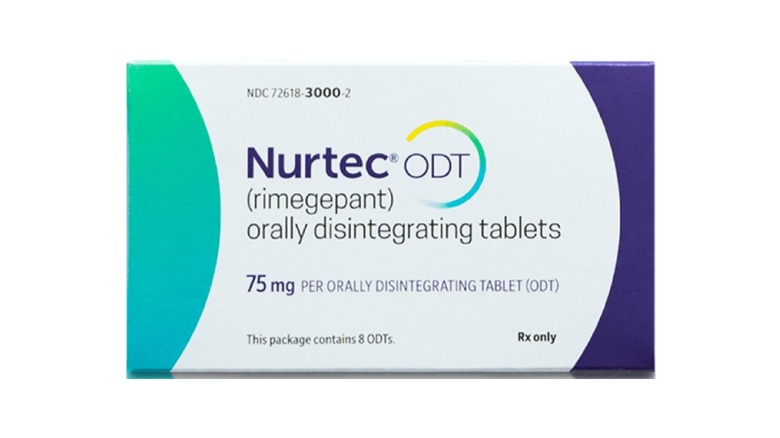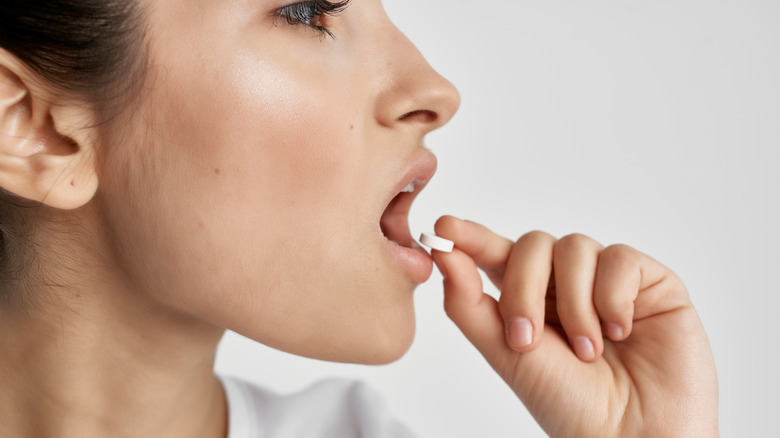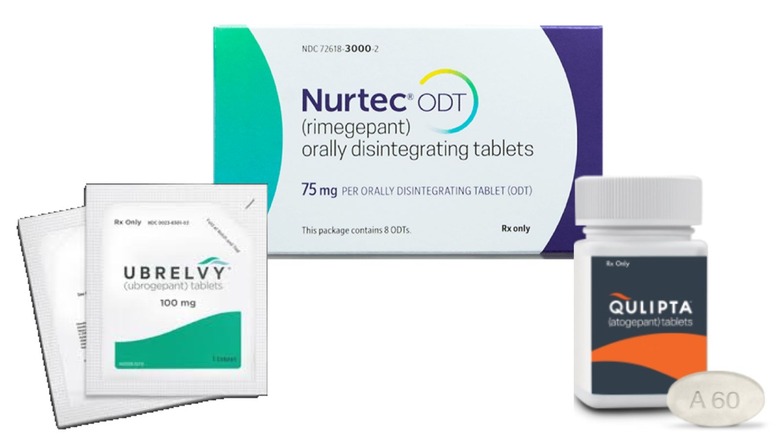The Khloe Kardashian Nurtec Commercial Explained: Drug Benefits, Side Effects, And More
Migraines can be debilitating. For those who have them, these severe headaches can get in the way of everyday life activities like work, exercise, socializing, and even sleep. Migraines are quite common, affecting about 12% of the U.S. population. Typically, migraines are characterized by severe throbbing pain in the head accompanied by nausea, vomiting, and sensitivity to sound.
The Nurtec ODT commercial featuring media personality, socialite, and model Khloe Kardashian may have caught your eye if you're interested in learning about migraine relief. An actual migraine patient herself, Kardashian is one of a few celebrities who have promoted the use of this drug. Singer and songwriter Lady Gaga was featured in a 2023 ad as well. "There's nothing glamorous about migraines," Kardashian is seen saying in the opening visuals of the commercial.
Nurtec ODT is supposedly a migraine drug that fights two things at once — treating the headache and preventing it. The claim is that it's the only medication that can do both. In fact, "treat and prevent all in one," seems to be its selling point in the commercials. What exactly is Nurtec ODT, how does it work, and what are its side effects?
What is Nurtec ODT and what does it do?
Nurtec orally disintegrating tablet, or ODT, is the brand name for the prescription drug rimegepant and is manufactured by Biohaven Pharmaceutical Holding Company Ltd., now a part of Pfizer Inc. The U.S. Food and Drug Administration (FDA) approval for this migraine relief drug came in 2021. There are no generic versions of the drug yet.
Rimegepant belongs to a class of drugs called calcitonin gene-related peptide (CGRP) inhibitors, medications that block CGRP from binding to CGRP receptors. Among other processes, CGRP is known to cause the dilation of cerebral and dural blood vessels, the release of inflammatory mediators, and the transmission of signals from intracranial blood vessels to the nervous system, all of which are factors associated with migraine headaches. Nurtec ODT is thought to inhibit all of these.
Nurtec ODT is meant for the acute treatment of migraine attacks, with or without aura, and as a preventative medication for episodic migraines. There are different types of migraine auras. They are sensory, motor, and/or speech-related warning signs of a migraine that include muscle weakness, vision changes, sensitivity to touch, ringing in your ears, numbness, tingling, and trouble with speaking and concentrating.
According to the company website, Nurtec ODT can provide relief from migraine pain in just two hours and keep you free from headaches for up to 48 hours. In clinical trials, some people were able to resume their normal activities in 60 minutes. The dissolvable drug can also allegedly reduce the number of migraine headaches you get in a month. Per clinical trials, people noticed 4.3 fewer monthly migraine days (MMD) during weeks 9-12 when consuming Nurtec ODT.
Nurtec ODT side effects
Your age, health condition, and any other medications you might be on could influence the side effects you experience. The most common side effect of Nurtec ODT is nausea. This was observed in clinical trials for acute treatment of migraine attacks, with or without aura. Nausea was also observed when the drug was used as a preventive treatment for episodic migraine. In the latter instance, other side effects like stomach pain and indigestion were also observed. Nausea after consuming the drug can be managed at home with home remedies like resting in a cool, quiet, and dark place, applying a cool compress to your head, hydrating well, or breathing exercises; but if nausea persists, it is recommended that you speak with your doctor. Over-the-counter nausea relief medication can also help.
Although rare, the more serious side effect of Nurtec ODT is that you could have an allergic reaction to the active ingredient, rimegepant, or any of the inactive ingredients in the drug — benzyl alcohol, eucalyptol, gelatin, limonene, mannitol, menthol, menthone, menthyl acetate, sucralose, and vanillin. Symptoms include difficulty breathing; rash; and swelling of the face, mouth, throat, and tongue. Hypersensitivity to the drug can occur days after administration. While this was noted as the only serious side effect of Nurtec ODT, you can get a list and explanation of all of its adverse reactions either via Prescribing Information or Patient Information.
Nurtec ODT dosage
Nurtec ODT comes in one strength — 75 milligrams — and the recommended dosage for acute treatment of migraine is 75 milligrams taken orally when the migraine symptoms come on. As a preventive treatment for episodic migraine, you're expected to consume 75 milligrams orally every other day. The maximum dose you can take within a 24-hour period is 75 milligrams and the implications/safety of consuming more than 18 doses within a 30-day period have not been established.
The orally disintegrating tablet comes in a blister pack. It is recommended that you peel the pack (with dry hands) to extract the pill without trying to push the tablet out through the foil. You shouldn't store an exposed tablet outside of the blister pack for later use. Once uncovered, immediately place the tablet either under or on top of your tongue. The drug will dissolve on its own and you don't need to drink water to help ingest it. Patient reviews of the drug note that the pill tastes minty.
Tracking your doses is recommended. Nurtec ODT can be prescribed as a long-term treatment for migraine by your healthcare provider. If you miss a dose and remember to take it soon after you missed it, then it is okay to consume the next pill, but if you're closer to your next dose when you remember, it's recommended that you skip the missed dose and resume from your next dose without double-dosing. In case of overdose, call Poison Control at 800-222-1222. Store the pills away from children, pets, and moisture in the blister package they come in, at room temperature (between 68 degrees Fahrenheit to 77 degrees Fahrenheit).
Nurtec ODT precautions
In addition to discussing whether you might be allergic to any of the drug's ingredients with your doctor, it is important to talk about underlying health conditions and any other prescription medications, over-the-counter medications, vitamins, or herbal supplements you're on.
Those with liver problems and kidney issues should be especially vigilant. Kidney and liver problems can mess with your body's ability to rid itself of the drug. In fact, per clinical trials, the exposure to Nurtec ODT was significantly higher in people with severe hepatic impairment. Even though it's unknown if Nurtec ODT can harm your unborn baby, you should discuss treatment with this drug with your healthcare provider if you are pregnant or you're trying to get pregnant. According to the company's Patient Information, there is a study called Migraine Observational NURTEC Pregnancy Registry, or MONITOR, where information is being collected about this particular concern. To learn more, visit the registry website or call 877-366-0324. Very small amounts of Nurtec ODT can pass on to your infant while breastfeeding so this is a concern you should be discussing with your doctor, too.
There is no data on this drug's interaction with alcohol but consuming alcohol can be a trigger for migraines in most people. You may want to run this by your doctor, just in case. It is unknown if Nurtec ODT is safe or effective for children.
Avoid taking Nurtec ODT if you are on these medications
Strong CYP3A4 inhibitors, moderate CYP3A4 inhibitors, strong and moderate CYP3A inducers, and potent Inhibitors of P-gp are thought to be concerns when consumed alongside Nurtec ODT.
Strong CYP3A4 inhibitors can affect the metabolization of Nurtec ODT and also increase your risk of side effects. It is recommended that you avoid taking these medications together. Strong CYP3A4 inhibitors to watch out for include:
- clarithromycin
- atazanavir (Reyataz)
- itraconazole (Sporanox)
- ketoconazole
With moderate CYP3A4 inhibitors, the advice is to avoid taking Nurtec ODT within 48 hours after taking a moderate CYP3A4 inhibitor. These can also mess with how you metabolize the migraine relief drug. Moderate CYP3A4 inhibitors to avoid include:
- amiodarone (Pacerone)
- diltiazem (Cartia XT, Tiazac)
- fosamprenavir (Lexiva)
Avoid consuming strong and moderate CYP3A inducers at the same time. These can make the migraine relief drug less effective by making your body metabolize the ODT faster. Pills to watch out for:
- carbamazepine (Tegretol)
- rifampin (Rifadin)
- phenytoin (Dilantin)
With potent inhibitors of P-gp, the advice is similar to that of moderate CYP3A4 inhibitors — avoid another dose of Nurtect ODT within 48 hours of taking one. Potent inhibitors of P-gp can elevate levels of Nurtec ODT and exacerbate side effects. Drugs to watch out for include:
- cyclosporine (Sandimmune)
- verapamil (Verelan)
- sulfasalazine (Azulfidine)
This might not be an exhaustive list of drug interactions, so you may want to bring up this topic with your doctor or pharmacist if you are prescribed Nurtec ODT.
How much does Nurtec ODT cost?
Factors like your dosage, whether or not you have health insurance, and the pharmacy you frequent can affect the cost of Nurtec ODT. According to the company website, 255+ million people can get the drug covered via their insurance, and 96% of people with commercial insurance are covered as well.
If you're planning to use insurance, check with them to get prior authorization for coverage. Your healthcare provider and insurance company would have to discuss the particulars before an authorization goes through. You could get a 90-day supply if it is approved, which could benefit you when it comes to cost deductions. Depending on what gets authorized, you may have either a co-pay or have to finance the drug yourself until you reach your deductible. If you don't have insurance, you could opt to pay cash price but the cost is going to be higher. Your doctor or pharmacist will be your resource person for specific information related to your situation.
Additionally, Nurtec ODT offers a OneSource help program. You will, however, require private insurance to be eligible for this offer. Medicare or other government insurance programs don't qualify. For more information, visit the patient support section on the company website. Other useful websites to check for financing help include NeedyMeds and Medicine Assistance Tool.
Ubrelvy, Qulipta, and Nurtec ODT: What's the difference?
Ubrelvy, which is manufactured by AbbVie, is a prescription medication used to treat migraine attacks with or without aura in adults. It is not, however, recommended for the prevention of migraine. It's supposed to work in as quickly as two hours when taken orally. Ubrogepant is the active ingredient in the drug and it belongs to the class of medications called calcitonin gene-related peptide (CGRP) antagonists. Antagonists work by reducing the effect of a natural chemical while inhibitors bind to their receptors and decrease their activity levels. Ubrelvy is slightly different in how it works in this regard when compared with Nurtec ODT. However, Ubrelvy is a brand-name drug too, with no other generic versions available in the market just yet.
Mild side effects of Ubrelvy vary too, when compared with Nurtec ODT. They include drowsiness, dizziness, nausea, and dry mouth. When it comes to serious side effects, an allergic reaction (although rare) is what you should be concerned about. Interestingly, former tennis player, Serena Williams appeared in one of Ubrelvy's commercials.
Qulipta, also manufactured by AbbVie, is a prescription medication (generic name: atogepant) used to prevent migraines in adults. It has not been studied for use as a treatment to bring relief to ongoing migraines. Like Ubrelvy, it is classified as a CGRP antagonist. Qulipta is also only a brand-name medication. Its mild side effects include loss of appetite, weight loss, nausea, constipation, and fatigue. Although serious side effects were not observed during clinical trials, it is possible that you could have an allergic reaction to the ingredients found in the drug.







